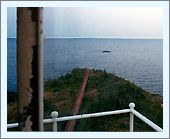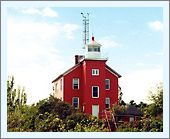|
Continued

With an increase in passenger traffic throughout the lakes at the
turn of the century, Marquette became a frequent stopping point along
the way for vacationers, with Lighthouse Point a popular place to spend
a sunny afternoon walking the beach and touring the lighthouse. Weekend
crowds on the Point frequently numbered in the hundreds, and Carlson
found himself spending more time policing the reservation to prevent
damage by the careless and rowdy. After discovering a number of picnic
parties lighting fires on the Point in June of 1903, Carlson was
concerned that such a fire might burn out of control and threaten the
station itself. Bound by policy to make visitors welcome at all times,
Carlson sent a letter to Eleventh District Inspector Herbert Winslow,
seeking his guidance. Winslow's letter of reply arrived on July 1,
stating simply that "picnic parties and camp fires would hereafter
not be allowed."
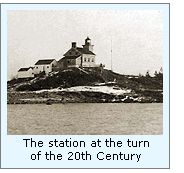 While walking the property on the
evening of July 6, 1903, Carlson came across a group of picnickers among which
was David Shelton, the number two surfman at the Marquette Life Saving
station. Seeing that the group had lighted a bonfire among a grove of
trees, Carlson informed the group that bonfires were forbidden on the
lighthouse reservation, extinguished the fire and dispersed the group.
At 10 o'clock the next morning, Carlson and Assistant Alfred Evensen
were on their way to the breakwater when surfman Shelton appeared on the
scene and brutally assaulted Carlson. Confined to bed for the following
two weeks, it was questionable as to whether Carlson would regain his
sight, since he was so severely beaten around the head. Since Evensen
apparently stood by and observed the beating without lifting a finger to
assist him, Carlson feared that Evensen was complicit to the beating,
and appointed his wife to fill in as Keeper during his recovery. While walking the property on the
evening of July 6, 1903, Carlson came across a group of picnickers among which
was David Shelton, the number two surfman at the Marquette Life Saving
station. Seeing that the group had lighted a bonfire among a grove of
trees, Carlson informed the group that bonfires were forbidden on the
lighthouse reservation, extinguished the fire and dispersed the group.
At 10 o'clock the next morning, Carlson and Assistant Alfred Evensen
were on their way to the breakwater when surfman Shelton appeared on the
scene and brutally assaulted Carlson. Confined to bed for the following
two weeks, it was questionable as to whether Carlson would regain his
sight, since he was so severely beaten around the head. Since Evensen
apparently stood by and observed the beating without lifting a finger to
assist him, Carlson feared that Evensen was complicit to the beating,
and appointed his wife to fill in as Keeper during his recovery.
Evidently Carlson was effected deeply
by the incident, as an unusual "station swap" was arranged to
get him away from the station. On October 16, 1903, Carlson left
Marquette for Whitefish Point, and the following day Charles Kimball,
the former Keeper at Whitefish Point arrived in Marquette to take over
in Carlson's place.
Kimball was 49 years of age, and a
seasoned keeper with 32 years of distinguished service under his belt.
After entering the service at 18 years of age on September 26, 1872, he
took his first assignment at Pointe Aux Barques Light Station on Lake
Huron where he served six years as the station's 1st Assistant. In
September of 1878, he accepted the promotion to Acting Keeper at the
newly established Port Austin Reef
Light, whereupon he was appointed as
the permanent Keeper in June of the following year. After four years at
Port Austin, he accepted a transfer to Whitefish Point at the opening of
the 1883 navigation season. Life for Kimball was relatively uneventful
in his first years at Marquette, although the dramatic increase in the
amount of visitors likely took some getting used to after the relative
isolation of Whitefish Point.
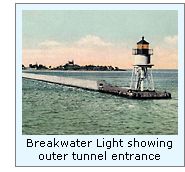 1908 marked the beginning of an
exceptionally busy three year period for Kimball. With the Army Corps of
Engineers working in the harbor completing an extension to the
breakwater, the old breakwater tower now stood isolated in the middle of
the structure, and plans were underway for the erection of a new cast
iron beacon at the revised terminus. To enable vessel masters to better
locate the end of this revised breakwater in thick weather, plans also
included the installation of an electrically-operated fog bell. On
hearing of this plan, the Marquette power company proposed that for $33
it could run a cable from the light and bell up to the dwelling, thereby
allowing Kimball and his Assistant Charles Ceary to remotely activate
either the bell or the light without having to make the trip out the
breakwater. With sufficient funding available, approval was obtained
from District Engineer Major Charles Keller, and the cable was
installed. With completion of the breakwater light and fog signal
imminent, Kimball received official notice on July 8, 1908 that
henceforth his title would change from "Keeper of Marquette light
station" to "Keeper of Marquette light station and Marquette
breakwater light." 1908 marked the beginning of an
exceptionally busy three year period for Kimball. With the Army Corps of
Engineers working in the harbor completing an extension to the
breakwater, the old breakwater tower now stood isolated in the middle of
the structure, and plans were underway for the erection of a new cast
iron beacon at the revised terminus. To enable vessel masters to better
locate the end of this revised breakwater in thick weather, plans also
included the installation of an electrically-operated fog bell. On
hearing of this plan, the Marquette power company proposed that for $33
it could run a cable from the light and bell up to the dwelling, thereby
allowing Kimball and his Assistant Charles Ceary to remotely activate
either the bell or the light without having to make the trip out the
breakwater. With sufficient funding available, approval was obtained
from District Engineer Major Charles Keller, and the cable was
installed. With completion of the breakwater light and fog signal
imminent, Kimball received official notice on July 8, 1908 that
henceforth his title would change from "Keeper of Marquette light
station" to "Keeper of Marquette light station and Marquette
breakwater light."
On July 15, the lighthouse tender
AMARANTH delivered a number of wooden crates containing a new Fourth
Order lens for the main light, and on August 17, Eleventh District
Lampist Thomas H Miller arrived at Marquette, and set about preparing
the main lantern for installation of the new lens. After disassembling
the old lens and lowering its components from the gallery, Miller
carefully placed the sections in crates for safe keeping until he could
install the old lens in the new breakwater tower. After lowering the
heavy cast iron fixed pedestal from the main tower, Miller set about
preparing the lantern floor for installation of the new pedestal.
Equipped with a revolving carriage mechanism, the pedestal was hoisted
to the gallery and bolted at the center of the lantern floor on August
19, 1908. Miller began the installation of the new lens on August 22,
completing the work three days later. Designed to rotate on the carriage
at a precise speed, the new lens displayed a characteristic fixed white
light punctuated by a single .04 second red "lightning flash"
once every 5 seconds.
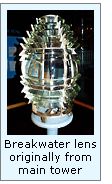 His work on the main light complete,
Mr. Miller then turned his attention to installing the old main lens in
the breakwater tower. Miller completed the work with the installation of
a red incandescent electric bulb on September 12, with both the
breakwater light and fog bell placed into commission that same day. With
Kimball and his current Assistant Oliver St. André now responsible for
the main Harbor Light, a first-class steam fog signal, two breakwater
lights and a breakwater fog bell, plans were being formulated in Detroit
for the addition of a 2nd Assistant keeper to the station's roster.
However, with only the main dwelling and the small assistant's dwelling
available, it was clear that additional accommodations would be required
before such a step could be taken. His work on the main light complete,
Mr. Miller then turned his attention to installing the old main lens in
the breakwater tower. Miller completed the work with the installation of
a red incandescent electric bulb on September 12, with both the
breakwater light and fog bell placed into commission that same day. With
Kimball and his current Assistant Oliver St. André now responsible for
the main Harbor Light, a first-class steam fog signal, two breakwater
lights and a breakwater fog bell, plans were being formulated in Detroit
for the addition of a 2nd Assistant keeper to the station's roster.
However, with only the main dwelling and the small assistant's dwelling
available, it was clear that additional accommodations would be required
before such a step could be taken.
Thomas H Miller returned to Marquette
on June 28, 1909 and installed a new incandescent oil vapor lamp system
within the main light lens. This new technology represented a
significant improvement over the old kerosene wick lamp, and increased
the light's range of visibility to 16 miles. The engineer's tender
AMARANTH arrived in the harbor on September 11, 1909, and over the
following six days unloaded tons of building materials for a major
reconstruction of the main dwelling planned for the following season.
Kimball oversaw the draying of the materials from the City dock to
Lighthouse Point, where they were safely covered and stored for the
coming winter.
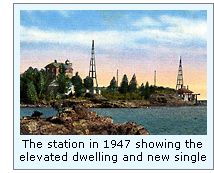 On May 24, 1910, AMARANTH returned to
Marquette and landed Construction foreman Young and a working party to
begin preparing the main dwelling for conversion into a duplex dwelling.
The following day, Kimball began moving all of his family's worldly
belongings out of the dwelling and into the old breakwater watchman's
cottage, which would serve as his temporary quarters until the
completion of the renovation. While one half of the crew worked on the
interior of the building, a second crew set to the exterior. By mid
June, the entire roof had been removed and the tender WARRINGTON arrived
in the harbor and deposited a load of bricks for the project. Masons
then set about vertically extending the side walls of the dwelling to
create a complete second story, with the apex of the roof almost three
feet higher than the gallery. Over July, electricians were working in
the building, wiring for lighting and electrical outlets throughout. The
masons completed their work on August 11, and the exterior crew set
about installing the new hipped roof. By October the hard construction
work was complete, a new steam heating system was being installed in the
cellar, and the carpenters were putting the finishing touches on the
interior trim work. Kimball moved back into the dwelling on October 26
along with 2nd Assistant Frank Otto, who had been assigned to the
station since May 26, and had been living in rented quarters in the
city. 1st Assistant Oliver St. André was the least inconvenienced by
the construction, staying in his quarters throughout the move. On May 24, 1910, AMARANTH returned to
Marquette and landed Construction foreman Young and a working party to
begin preparing the main dwelling for conversion into a duplex dwelling.
The following day, Kimball began moving all of his family's worldly
belongings out of the dwelling and into the old breakwater watchman's
cottage, which would serve as his temporary quarters until the
completion of the renovation. While one half of the crew worked on the
interior of the building, a second crew set to the exterior. By mid
June, the entire roof had been removed and the tender WARRINGTON arrived
in the harbor and deposited a load of bricks for the project. Masons
then set about vertically extending the side walls of the dwelling to
create a complete second story, with the apex of the roof almost three
feet higher than the gallery. Over July, electricians were working in
the building, wiring for lighting and electrical outlets throughout. The
masons completed their work on August 11, and the exterior crew set
about installing the new hipped roof. By October the hard construction
work was complete, a new steam heating system was being installed in the
cellar, and the carpenters were putting the finishing touches on the
interior trim work. Kimball moved back into the dwelling on October 26
along with 2nd Assistant Frank Otto, who had been assigned to the
station since May 26, and had been living in rented quarters in the
city. 1st Assistant Oliver St. André was the least inconvenienced by
the construction, staying in his quarters throughout the move.
With work complete on the breakwater
and main dwelling, attention turned toward the aging thirty-year old fog
signal buildings. On June 9, 1911. AMARANTH again put into Marquette
Harbor, and unloaded piping and supplies for the construction of a new
brick fog signal building. The vessel returned again on August 9 with
District construction foreman J. W. MacDonald, a work crew, and a huge
load of construction materials and tools which took eight days to
unload. On August 16, MacDonald began blasting rock at the end of the
point for the foundation of the new signal building. The keepers helped
out by delivering innumerable bags of cement to the work site in station
launch. After receiving orders from District Engineer Major Charles. S.
Bromwell late in August, the Keepers painted all brick surfaces of the
main dwelling and tower with two coats of bright red paint, hiding
forever the creamy yellow brick. By November 15, work on the fog signal
walls and roof was drawing to completion, when MacDonald received word
from Detroit to discontinue work for the season. Materials and equipment
were covered and secured for the onset of winter, and foreman MacDonald
left for Detroit.
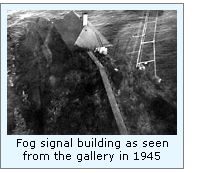 In February 1912, Kimball received word
from Detroit to hire a team and men to place the gasoline engines,
compressors and tanks in the new signal building in preparation for the
resumption of work. Kimball made the necessary arrangements, and over
the remainder of the month transported and placed the machinery in the
new building, and stowed the remainder of the mechanical equipment in
the old fog signal building, which was being kept operational until the
completion of the new plant. Foreman MacDonald and a small crew returned
to resume work on March 26. Over the following month, the engines and
plumbing were connected, radiators installed and the final concrete
floor poured. The Keepers painted both the interior and exterior of the
building, and helped unload twenty eight barrels of diesel fuel and
emptied them into the fuel tanks. On May 20, the diesel engines were
test fired, the compressors activated and the diaphones tested for the
first time. After minor adjustments, the new fog signal station was
officially placed into commission on May 22, 1912. As was the case with
the previous steam system, the new plant consisted of duplicate diaphone
systems, with one unit always standing at the ready in case the primary
system failed to function. MacDonald and his crew dismantled the
remaining wood-framed signal building, and departed for their next
assignment at Whitefish Point on May 31. In February 1912, Kimball received word
from Detroit to hire a team and men to place the gasoline engines,
compressors and tanks in the new signal building in preparation for the
resumption of work. Kimball made the necessary arrangements, and over
the remainder of the month transported and placed the machinery in the
new building, and stowed the remainder of the mechanical equipment in
the old fog signal building, which was being kept operational until the
completion of the new plant. Foreman MacDonald and a small crew returned
to resume work on March 26. Over the following month, the engines and
plumbing were connected, radiators installed and the final concrete
floor poured. The Keepers painted both the interior and exterior of the
building, and helped unload twenty eight barrels of diesel fuel and
emptied them into the fuel tanks. On May 20, the diesel engines were
test fired, the compressors activated and the diaphones tested for the
first time. After minor adjustments, the new fog signal station was
officially placed into commission on May 22, 1912. As was the case with
the previous steam system, the new plant consisted of duplicate diaphone
systems, with one unit always standing at the ready in case the primary
system failed to function. MacDonald and his crew dismantled the
remaining wood-framed signal building, and departed for their next
assignment at Whitefish Point on May 31.
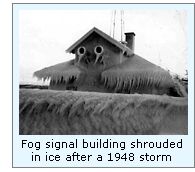 On November 23 of that same year, a
gale accompanied with heavy snow blew in from the Northeast, with the
heavy sea crashing over the protective wall, ripping shingles from the
fog signal roof and tearing away part of the dock. Attempting to sound
the signal the following day, Kimball found the mechanisms filled with
sand and the resonators cracked from the force of the waves, and
completely disassembled the system to remove all of the sand. It was not
until January 13, 1913 that Kimball received permission from Detroit to
hire a local crew to repair the damage to the signal building roof. On November 23 of that same year, a
gale accompanied with heavy snow blew in from the Northeast, with the
heavy sea crashing over the protective wall, ripping shingles from the
fog signal roof and tearing away part of the dock. Attempting to sound
the signal the following day, Kimball found the mechanisms filled with
sand and the resonators cracked from the force of the waves, and
completely disassembled the system to remove all of the sand. It was not
until January 13, 1913 that Kimball received permission from Detroit to
hire a local crew to repair the damage to the signal building roof.
With the major station upgrade
complete, life at the station settled into a busy routine that would
basically remain unchanged through the remainder of the station's active
years, with only minor changes and repairs being undertaken. At the age
of 66, Keeper Kimball retired from lighthouse service on April 20, 1925
after 43 years of service. Frank Sommer, a 55 year-old who had entered
lighthouse service at age 33 as Assistant at Big Bay, and spent the past
14 years as Keeper of the Detour Light, was transferred-in to take over
the station.
With an increasing reliance on radio
technology in navigation and communication, a number of steel towers
were built on Lighthouse Point in 1927, with radiobeacon and
radiotelephone transmitters installed in the fog signal building and
placed into service on April 20, 1928. The advent of radio presented the
keepers with new and unique problems. While in the past, a good
"backyard" mechanical sense would hold a keeper in good stead
in repairing mechanical light mechanisms and steam and diesel engines,
radio was something completely foreign to them, and the mystery
represented by the glowing vacuum tubes something for which their
experience left them completely unprepared. Combined with the unreliable
nature of the early equipment itself, the equipment was in a constant
state of breakdown. Radio technicians were dispatched from the Soo and
Duluth on an almost daily basis to assist the frustrated keepers in
keeping the transmitters humming. With traffic patterns changing in the
lake, the Lighthouse Bureau made the decision to automate the Granite
Island Light station at the opening of the 1938 navigation season
through the installation of an acetylene illuminating system equipped
with a sun valve. With live-in keepers no longer assigned to the island
station, responsibility for the maintenance of the automated system was
placed with the Marquette Keepers. On May 4, 1938 Frank Sommer and 3rd
Assistant Michael Salata boarded AMARANTH for Granite Island to receive
instruction on maintaining the new acetylene light. With the addition of
this responsibility, the Marquette Keepers began making nightly trips to
Presque Isle harbor, from where they could verify the operation of the
light on the horizon. While the acetylene system was equipped with a
bank of acetylene canisters, and expected to operate for months without
recharging, the Keepers frequently found the light extinguished or
burning poorly, and were forced to make the 12 mile trip out to the
island in the station launch to effect repairs. When seas were
particularly rough, station logs show the Life Saving crew frequently
rendered assistance by transporting the keepers to and from the island.
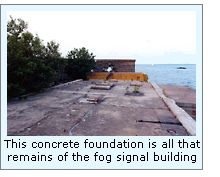 With the transfer of responsibility for
the nation's aids to navigation to the Coast Guard in 1939, a barely
documented flow of Coasties operating out of the life saving station
were assigned to assist the remaining lighthouse service keepers. With
the outbreak of World War II, the station became a Coast Guard training
station with up to 300 recruits living in the various station buildings.
The main dwelling became the primary Coast Guard station housing in the
1950's and to provide easier access, an addition enclosing a stairway
was added at the rear of the building. With the transfer of responsibility for
the nation's aids to navigation to the Coast Guard in 1939, a barely
documented flow of Coasties operating out of the life saving station
were assigned to assist the remaining lighthouse service keepers. With
the outbreak of World War II, the station became a Coast Guard training
station with up to 300 recruits living in the various station buildings.
The main dwelling became the primary Coast Guard station housing in the
1950's and to provide easier access, an addition enclosing a stairway
was added at the rear of the building.
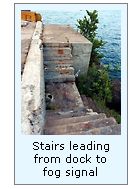 With the universal adoption of RADAR
and LORAN providing mariners with a succinctly identify their position
relative to the shore and other obstructions at night or in the thickest
weather, the fog signal no longer served its original purpose. Oblivious
to the historical value that the structure for future generations, the
Coast Guard destroyed the structure in the 1980's. leaving only the
concrete foundation and dock stairs remaining as evidence of the
existence of this once vital building. With the universal adoption of RADAR
and LORAN providing mariners with a succinctly identify their position
relative to the shore and other obstructions at night or in the thickest
weather, the fog signal no longer served its original purpose. Oblivious
to the historical value that the structure for future generations, the
Coast Guard destroyed the structure in the 1980's. leaving only the
concrete foundation and dock stairs remaining as evidence of the
existence of this once vital building.
In 2002, the Marquette Maritime Museum
obtained a 30-year lease on the lighthouse building and approximately 2
˝ acres of Lighthouse Point. Already in their first year of ownership,
the first floor of the building has been restored with the help of High
School Shop students, with the floors stripped and varnished and the
walls patched and painted. The Museum plans to develop the main floor of
the lighthouse as an extension of the main museum, and plans to restore
and furnish the second floor to reflect the way it might have appeared
at the turn of the twentieth century.
The Marquette Harbor Light still serves
as an active aid to navigation, its lantern now housing a 300 mm
Tideland Signal acrylic optic, which emits a white flash every ten
seconds.
Keepers of
this Light

Click here
to see a complete listing of all Marquette Light keepers compiled by
Phyllis L. Tag of Great Lakes Lighthouse Research.
Finding this Light

Take Front Street North into Marquette, and turn right toward the Lake
on Main St. Take Main St. down the hill to the Lake, and turn left on
Lakeshore Drive. Follow Lakeshore Drive around the bay. At the point
where Lakeshore Dr. sweeps to the left, you will see the Coast Guard
building and the brick Maritime Museum to your right. Pull in and park
at the Maritime Museum. The property on which the lighthouse sits is
owned by the Coast Guard, and "no trespassing" signs are
posted conspicuously around the area. As described in the Observations
section above, we suggest that you enter the museum, and find out
when tours will be given, in order to gain close access to the light.
Contact
information

For information about the museum and
tours of the lighthouse visit the Maritime Museum website
at or contact the museum at:
Marquette Maritime Museum
300 Lakeshore Boulevard
Marquette, Michigan 49855
Telephone: (906) 226-2006
Reference Sources

History of the Great Lakes, J H Beers Co., Chicago, 1899
Long Ships Passing, Walter Havighurst, 1948
Annual reports of the US Lighthouse Board, various, 1853 through
1909.
Annual reports of the US Lighthouse Bureau, various, 1910 through
1939
Great Lakes Light Lists, various, 1873 through 1999
Annual reports of the Lake Carrier's Association, various, 1902
through 1950.
Station log books of the Marquette Light Station, 1873 through
1940.
Email correspondence with Don Nelson, various, 07/02 - 08/02
Email correspondence with Frederick Stonehouse, various,
02/01 -
08/02
Personal observations made at the station in September 1998 and July
2002
Instructions to Light Keepers, US Lighthouse Board, 1902.
Northern Lights, Charles K Hyde, 1986
Keeper listings for this light appear
courtesy of Great
Lakes Lighthouse Research
|
